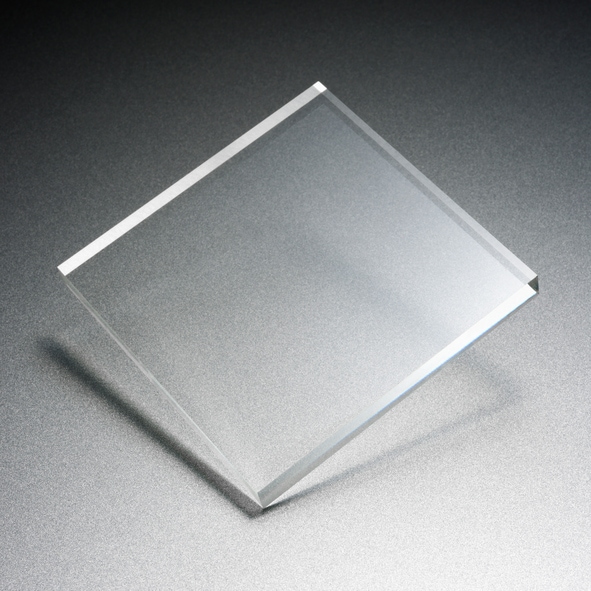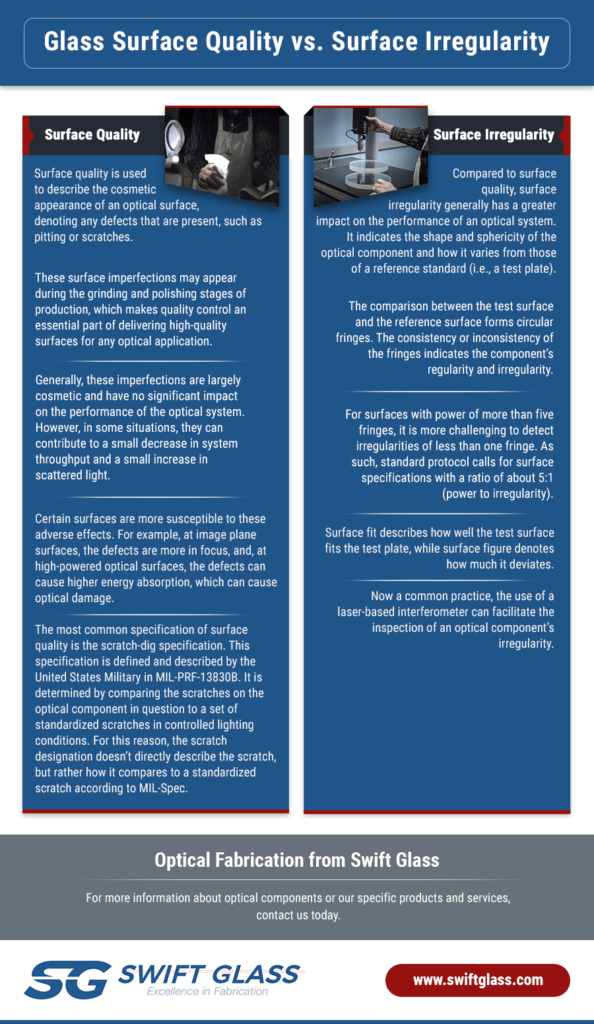Glass Surface Quality vs. Surface Irregularity
Leave a CommentDuring the design and production of optical devices and systems, optical specifications—such as surface quality and surface irregularity—serve two key purposes:
- To set the acceptable limits for various performance parameters
- To determine the amount of resources required for production
While an optical component may appear to be perfect—i.e., without defect—to the human eye, there may still be minuscule surface quality issues and irregularities that affect the performance of the optical device when the component is used. In optics, operations often occur on scales measured in nanometers or billionths of a meter. As such, even the slightest variation in a component can cause significant distortion or degradation of optical quality.
Understanding how the surface of an optical component may vary and how those variations affect performance are crucial to determining which parts are right for a given application. The following blog post provides an overview of two commonly utilized optical specifications—surface quality and surface irregularity.
Overview of Surface Quality
Surface quality is used to describe the cosmetic appearance of an optical surface, denoting any defects that are present, such as pitting or scratches. These surface imperfections may appear during the grinding and polishing stages of production, which makes quality control an essential part of delivering high-quality surfaces for any optical application.
Generally, these imperfections are largely cosmetic and have no significant impact on the performance of the optical system. However, in some situations, they can contribute to a small decrease in system throughput and a small increase in scattered light. Certain surfaces are more susceptible to these adverse effects. For example, at image plane surfaces, the defects are more in focus, and, at high-powered optical surfaces, the defects can cause higher energy absorption, which can cause optical damage.
The most common specification of surface quality is the scratch-dig specification. This specification is defined and described by the United States Military in MIL-PRF-13830B. It is determined by comparing the scratches on the optical component in question to a set of standardized scratches in controlled lighting conditions. For this reason, the scratch designation doesn’t directly describe the scratch, but rather how it compares to a standardized scratch according to MIL-Spec. For more info, see this Scratch-Dig Specification Guide.
Overview of Surface Irregularity
Compared to surface quality, surface irregularity generally has a greater impact on the performance of an optical system. It indicates the shape and sphericity of the optical component and how it varies from those of a reference standard (i.e., a test plate).
The comparison between the test surface and the reference surface forms circular fringes. The consistency or inconsistency of the fringes indicates the component’s regularity and irregularity. For surfaces with power of more than five fringes, it is more challenging to detect irregularities of less than one fringe. As such, standard protocol calls for surface specifications with a ratio of about 5:1 (power to irregularity). Surface fit describes how well the test surface fits the test plate, while surface figure denotes how much it deviates.
Now a common practice, the use of a laser-based interferometer can facilitate the inspection of an optical component’s irregularity.
Optical Fabrication from Swift Glass
Optical components are found in many devices and systems, ranging from consumer cameras to machine vision imaging devices to biometric iris identification systems. Which components are employed depend on the application. The type, specifications, and tolerances need to meet the performance requirements as well as justify the investment cost.
At Swift Glass, we are fully committed to fabricating the highest quality optical components in the market. Before delivery, we subject each piece—whether in prototype or full-production runs—to several levels of quality control. These inspection processes, including first-piece inspection, random sampling, and final inspection, ensure all of our products meet customer requirements and our quality standards.
For more information about optical components or our specific products and services, contact us today. Additionally, check out our new interactive conversion tool designed to calculate measurement conversions from micron to fringe to wave.
5 Key Benefits of Fused Silica & Quartz
Leave a CommentFused silica and quartz are two commonly employed materials in glass fabrication operations. Both substances offer unique properties that make them suitable for use in fabricated glass components. The following blog post provides an overview of the two, including their composition, key benefits, and typical applications.
Benefits of Fused Silica Glass
 Fused silica is a non-crystalline synthetic material comprised of silicon gas or silica sand. Since it is synthetically processed, it is the purest form of glass on the market, both structurally and physically. Its cross-linked three-dimensional structure results in exceptional thermal resistance and near-zero thermal expansion.
Fused silica is a non-crystalline synthetic material comprised of silicon gas or silica sand. Since it is synthetically processed, it is the purest form of glass on the market, both structurally and physically. Its cross-linked three-dimensional structure results in exceptional thermal resistance and near-zero thermal expansion.
Some of the key benefits of using this glass material include:
- High chemical purity and resistance
- High softening point and strong thermal resistance
- Low thermal expansion and high thermal shock resistance
- High transparency from ultraviolet to infrared spectral range
- High radiation resistance
Benefits of Quartz Glass
Quartz is a naturally occurring crystalline mineral comprised of oxygen and silicon. It is one of the most abundant minerals on the planet and forms in most rock types in the Earth’s crust. When converted into glass, it’s found in applications in many scientific research and other high-tech operations.
Some of the key benefits of using this glass material include:
- Good transmission behavior in the ultraviolet range
- High-temperature endurance in the visible and infrared range
- Low coefficient of thermal expansion and high thermal shock resistance
- Exceptional electrical insulation and high chemical purity
- Suitability for permanent operation at 1100° C or short-term operation at 1300° C
Applications of Fused Silica and Quartz Glass
Both fused silica and quartz glass are ideal for use in many different industrial applications, including the following:
- Chemical and pharmaceutical processes. Chemical and pharmaceutical manufacturing operations experience a wide range of conditions, including exposure to high temperatures, corrosive chemicals, and water. Parts and components made from fused silica and quartz are ideal for use in these environments as they are chemically pure, chemical resistant, non-hygroscopic, and thermal shock resistant.
- Electronics and electro-technology. Electronics and electronic technology rely on both conductive and insulating components. For the latter, fused silica and quartz are ideal as a construction material as they offer low conductivity, high penetration field strength, and low electric loss factor.
- High-temperature operations. The thermal properties of both materials allow them to withstand high processing temperatures without risk of damage or degradation.
- Light and laser technology. Many light-based systems (e.g., lasers) rely on glass optical components—such as ones made from fused silica and quartz—to focus or separate light to perform their operations.
- Optical system components. Fused silica and quartz are used in the manufacture of many optical parts—such as lenses, mirrors, UV and IR transmitting optics, and metrology components—due to their ability to transmit light in the visible, ultraviolet, and infrared range.
- Semiconductors. The purity of the two materials is particularly essential for components such as semiconductors, which play a role in many systems used in critical applications.
- UV light sanitation. UV light sanitation serves as a non-toxic alternative to disinfection. As both fused silica and quartz demonstrate high thermal and radiation resistance, they are suitable for use in equipment subjected to such operations, such as semiconductor components and medical and laboratory instruments.
Fused Silica and Quartz Glass From Swift Glass
At Swift Glass, we have provided quality custom glass fabrication for nearly 100 years. We stock a wide range of fused silica and quartz glasses from a variety of manufacturers, each of which offers unique advantages. For example, our fused silica demonstrates a cross-linked, three-dimensional structure that results in high thermal shock resistance, UV and IR transparency, and near-zero thermal expansion. Some of our other product offerings include:
- Industrial- and commercial-grade fused silica and quartz for sight glasses
- UV-fused silica for applications requiring low content of inclusion and/or high refractive index homogeneity
For additional information about fused silica and quartz or our products and services, contact us or request a quote today.







